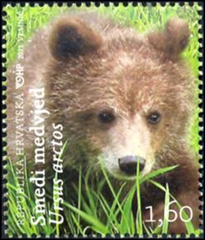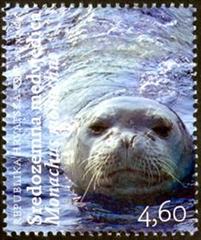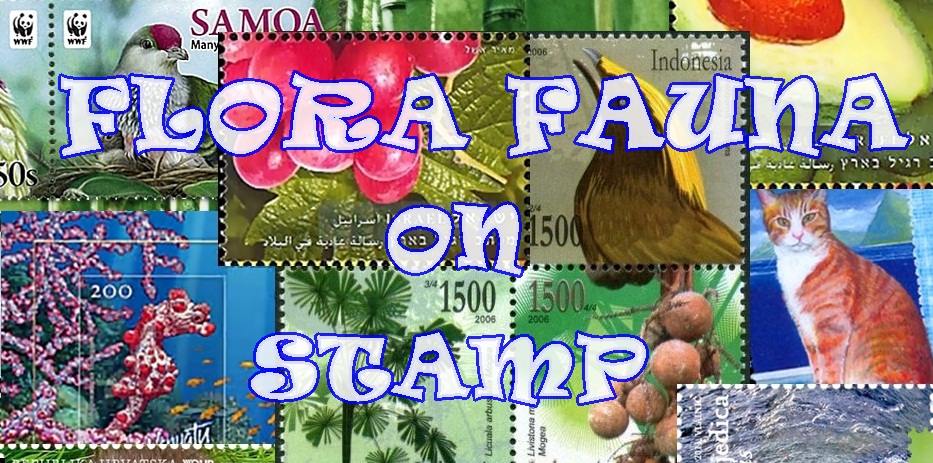On 15 March 2011, the Croatia Post issued the endangered species stamp series in 3 postage stamps. This issue depicts the Elenora’s Falcon, the Brown Bear, and Mediterranean Monk Seal.

Eleonora’s Falcon is a smaller species of falcon, 36 – 42 cm long, weighting 350 – 450 g and with wing span of 87 – 104 cm. It comes in two varieties – light and dark – and sexes are distinguished by the colour of eye ring and vax gland. With mail it is in yellow and with female in blue.
In Croatia there are 80 – 90 nesting pairs, which is somewhat more than 0,5% of the world’s population. According to newest estimations total world population is 15.000 nestling pairs, of which more than 80% in Greece. Eleonora’s falcon is listed in Red Book as endangered species in Croatia (EN), and is strictly protected by law.
Eleonora’s falcon nests in colonies, laying two to four eggs on mostly unapproachable cliffs of islands at sea, in August and September. Croatia is an edge area for this species, and entire or almost entire Croatian population mainly inhabits the islands of Vis, Svetac and Biševo and the nearby islets, but single birds have also been spotted on the islands of Palagruža and Jabuka.
 Brown Bear (Ursus arctos), one of the eight species of bears in the world.It belongs to the order of beasts (Carnivora) and the family of bears (Ursidae).
Brown Bear (Ursus arctos), one of the eight species of bears in the world.It belongs to the order of beasts (Carnivora) and the family of bears (Ursidae).
Brown Bear’s nutrition are 95% of plant food, while for the rest of 5% of animal proteins, mainly invertebrates and large animal carcasses. In spring and summer dominate herbaceous plants and grasses, supplemented with various soft fruits .
In Croatia, the females grown-up weight between 100 – 130 kg, and males between 150 – 200 kg, some even up to 300 kg. The body is covered by long fur and thick under-fur predominantly brown, often dark brown, even black, on the spine.
There are claws on the foot-fingers , especially long on front legs (about 5 to six cm) and very strong. The bear uses them to dig in the ground, in rotten stumps and ant hills, to turn over stones, to kill and tear the prey. The bear’s denture has all the characteristics of beasts with typical incisors, canines and carnassials.
In November the bear prepares his lair. In Croatia areas the majority of lairs are found in smaller hollows in rocks which the bears adapt to their needs by digging. In the area of 12.000 km2 of Gorski kotar and Lika there live about 1,000 bears.
The bears mate from the end of May to the middle of July, and the cubs are born in January during hibernation. The female bear give birth to1-4 cubs weighting about 350 g, blind and almost furless. The female feeds cubs with its milk containing about 22% fat and 12% proteins.
The cubs spend with their mother their first year of life and the next winter in liar, and are ready to separate at the age of 1,5 year. The bears mature in three to four years, and can live in nature between 10 and 20 years.
Today in Croatian a bear has the status of hunted wildlife and can be hunted outside reserve areas. The limited size of available habitat and a vast space fact results in the status of a rare species.

Mediterranean Monk Seal or Monachus monachus is belongs to the order of fin-footed animals (Pinnipedia), family of earless seals (Phocidae), genus of monk seals (Monachus). It is two to three meters long and can weight up to 400 kg. It is the biggest animal in the family of seals. In outer look there is no difference between the sexes. A female is mature at the age of five and a male at the age of 7 years; they mate and feed only in water.
Today it lives in small colonies in the Mediterranean and Atlantic, along the coastline of Mauritania – Morocco. Total population consists of about 350 single monk seals, living in small isolated colonies of 5 to 7 monk seals, the biology of which is not well known yet. In the Adriatic, a population of 60 specimens, and today this number has reduced to 20 specimens.
Mediterranean monk seal has got big round eyes and 30 pointed teeth. On front fins it has got very well developed claws, while they considerably smaller on back fins. It eats 10 to 12 kg of food daily. They feeds on cephalopods, crabs and molluscs.
Mediterranean monk seal is adapted to living in sea. It has no auricles, it can not turn rear fins forwards; they are always stretched behind, so that it always moves clumsy on land, but thanks to its hydrodynamic form they move very masterly and fast in the water.
Mediterranean monk seal can live up to 40 years. Gestation period is 10 to 11 months, so that every second year a female gives birth to one youngling 60 to 80 cm long , weighting 40 to 60 kg. The youngling sucks 10 to 18 weeks.
Mediterranean monk seal has been protected in Adriatic since 1935 by the “Dalmatian Decree“ and on the basis of the Law on Nature Protection a fine of 100 thousand Croatian kuna is foreseen for disturbing and killing them. ( Resources from Estonia Post Office).

No comments:
Post a Comment